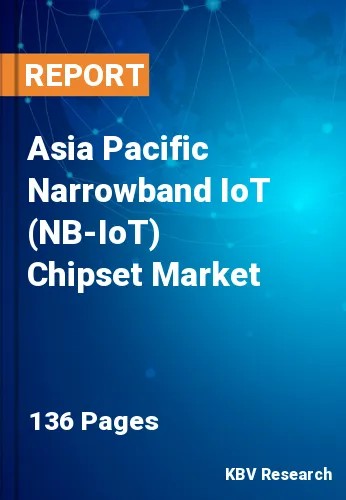The Asia Pacific Narrowband IoT (NB-IoT) Chipset Market would witness market growth of 52.1% CAGR during the forecast period (2022-2028).
For M2M and Internet of Things (IoT) devices and applications that require wireless communication over a greater range at a reasonably low cost and utilizing minimal power for long battery lives, NB-IoT (Narrowband-IoT) is a narrowband radio technology. Small data volume levels must regularly be sent in NB-IoT applications. In recent years, when NB-IoT became the industry standard for this kind of wireless communications, mobile carriers have been building up their networks to support customers' access to narrowband-IoT.
LTE Cat-NB is one of the names given to NB-IoT. The recent NB-IoT specification also runs by the names LTE Cat-NB1 and Cat N1. There are currently Cat N2 or Cat NB2 devices that use the later, improved NB-IoT requirements and are in the process of being commercially available. Various wireless IoT communication standards that enable the use of battery-powered devices for transfer over a broad area or WAN, in this case, wireless WAN with comparatively lower power for infrequent, primarily small data volume transmissions go by this name.
Since NB-IoT is a cellular technology, it uses cellular bands for communication and was created to function in three different ways, including replacing existing deployments using the GSM band (standalone), sharing the LTE band with other devices (in-band), or maximizing the communication spectrum by utilizing the space between LTE channels.
The main driver propelling the growth of the NB-IoT chipset market in APAC is the expanding acceptance of NB-IoT technology in numerous applications, including smart parking, smart meters, smart streetlights, and healthcare. APAC's market is currently dominated by China. The main drivers of the market's growth in China are favorable government policies and a significant presence of NB-IoT chipset, module, and infrastructure suppliers in the country. IoT will continue to be in demand in important industries like healthcare and utilities due to technology improvements and digitalization in nations like China and India.
The China market dominated the Asia Pacific Narrowband IoT (NB-IoT) Chipset Market by Country in 2021, and would continue to be a dominant market till 2028; thereby, achieving a market value of $789.7 million by 2028. The Japan market is estimated to witness a CAGR of 51.1% during (2022 - 2028). Additionally, The India market would exhibit a CAGR of 53% during (2022 - 2028).
Based on Application, the market is segmented into Alarms & Detectors, Smart Meters, Trackers, Wearable Devices, Smart Parking, and Others. Based on Deployment, the market is segmented into Guard, In-band, and Stand-alone. Based on Offering, the market is segmented into Hardware (Processor, Memory, and Power Management Unit) and Software. Based on Vertical, the market is segmented into Infrastructure, Energy & Utilities, Automotive & Transportation, Agriculture, Healthcare & Dental, and Others. Based on countries, the market is segmented into China, Japan, India, South Korea, Singapore, Malaysia, and Rest of Asia Pacific.
Free Valuable Insights: The Worldwide Narrowband IoT (NB-IoT) Chipset Market is Projected to reach USD 7.7 Billion by 2028, at a CAGR of 51.6%
The market research report covers the analysis of key stake holders of the market. Key companies profiled in the report include Samsung Electronics Co., Ltd., Intel Corporation, U-blox Holding AG, Sequans Communications S.A., Huawei Technologies Co. Ltd., Qualcomm, Inc., Nordic Semiconductor ASA, MediaTek, Inc., Sercomm Corporation and Sanechips Technology Co., Ltd
By Application
By Deployment
By Offering
By Vertical
By Country
Our team of dedicated experts can provide you with attractive expansion opportunities for your business.

